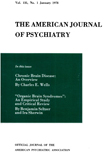PSYCHOTHERAPY IN THE COMBAT ZONE
Abstract
Effective techniques of combat psychotherapy have been evolved through experiences gained in World War I, World War II, and the Korean campaign. They include the following basic principles: (1) the location or level where treatment is performed should be as near the battlefront or combat group as practicable, preferably at the level of the battalion aid station; (2) best results of treatment are obtained by methods that combine simplicity and brevity; repression and suppressive techniques are more effective than uncovering procedures; (3) psychiatric facilities function more effectively if all assigned personnel make consistent efforts to create a therapeutic atmosphere that reflects positive motivation; (4) success in therapy is largely determined by the degree with which the psychiatrist identifies with the needs of the combat group, as opposed to his participation with the desires of the individual.
Access content
To read the fulltext, please use one of the options below to sign in or purchase access.- Personal login
- Institutional Login
- Sign in via OpenAthens
- Register for access
-
Please login/register if you wish to pair your device and check access availability.
Not a subscriber?
PsychiatryOnline subscription options offer access to the DSM-5 library, books, journals, CME, and patient resources. This all-in-one virtual library provides psychiatrists and mental health professionals with key resources for diagnosis, treatment, research, and professional development.
Need more help? PsychiatryOnline Customer Service may be reached by emailing [email protected] or by calling 800-368-5777 (in the U.S.) or 703-907-7322 (outside the U.S.).



